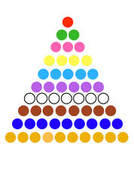_____________________________________________________________________________________________________________________
The Montessori Classroom
The Prepared Environment:
An essential part of the Montessori experience, the term ‘prepared environment’ refers to a classroom that contains all of the elements a young child needs to naturally respond to their individual desire to explore and learn. The environment provides the opportunity to take from the surrounding materials, which are child-sized and designed in a meaningful way, and aid the child in their discovery of the world around them.
This prepared classroom environment differs from the traditional classrooms as it is a multi-aged environment. The children work and learn from each other as they advance at their own pace. This also builds a sense of family and community, creating opportunities for the younger child to learn from their older classmates while it builds confidence and self-esteem in the older children as they share their knowledge with their younger classmates.
Essentially, this prepared environment becomes like a family atmosphere where a child feels safe and comfortable.
An essential part of the Montessori experience, the term ‘prepared environment’ refers to a classroom that contains all of the elements a young child needs to naturally respond to their individual desire to explore and learn. The environment provides the opportunity to take from the surrounding materials, which are child-sized and designed in a meaningful way, and aid the child in their discovery of the world around them.
This prepared classroom environment differs from the traditional classrooms as it is a multi-aged environment. The children work and learn from each other as they advance at their own pace. This also builds a sense of family and community, creating opportunities for the younger child to learn from their older classmates while it builds confidence and self-esteem in the older children as they share their knowledge with their younger classmates.
Essentially, this prepared environment becomes like a family atmosphere where a child feels safe and comfortable.
Areas of the Montessori Classroom:
Along with the prepared environment are the distinct areas of the classroom. Each of the areas deal with certain skills which as the children explore them all relate back to each other. There are five main areas in a Montessori Classroom: Sensorial, Language, Mathematics, Everyday Living/Practical Life and Geography/Culture.
Sensorial:
This area allows the children to explore each concept developing their senses. The children arrange and organize materials according to the concept they are exploring. They train themselves to observe, make comparisons, form judgments, reason and decide while they repetitively use the Montessori materials. Work in this area ends up being an indirect preparation for later more advanced mathematical concepts.
Everyday Living/Practical Life:
The practical life area helps a child explore and participate in hands on activities that teach the child how to function in the environment around them. Exercises such as pouring, spooning, sorting, food prep, care of self, care of the classroom environment, and grace and courtesy are included in their daily lives. The children learn to become independent and confident in their abilities while building their concentration and focus as the child learns simple everyday tasks.
Mathematics:
From their first introduction to the Montessori classroom, the child is encouraged to think mathematically and develop their own mathematical mind. They are welcomed into an ordered environment with each curriculum having its own unique area in the classroom. The placement of materials follows a specific order, with the simplest and most concrete material placed before the progressively more difficult, abstract materials, moving from left to right and top to bottom. The child’s ability to touch a ‘one’ or ‘hundred’ helps them to internalize the process of the mathematical concept. The Sensorial work carries over into the math area allowing them to begin this concrete exploration and move at their own pace into more abstract concepts.
Geography and Culture:
This area encompasses several smaller areas both physical and intellectual. Montessori looks at geography and culture together, working to bring awareness to the child of their place in the universe. Geography begins with the globe and works down through the physical aspects of the earth. Nature exploration brings experiences in biology, botany and zoology. The children also learn about the people and cultures of our human family, including exploration of our similarities and differences. The art and music included in this area, give the children an opportunity to enjoy creative activities.
Language:
Dr. Montessori developed the early childhood language curriculum to focus on multi-sensorial, incremental learning that respects each child's unique pace and readiness for language development. The child is presented with varied and engaging activities that develop auditory skills, speech, vocabulary, writing skills, reading, and an understanding of the patterns of language. Throughout the language curriculum, the child works on progressively complex concepts that continuously build upon his prior knowledge The activities can be divided into four main areas: Oral Language, Writing, Reading, and Parts of Speech.
Along with the prepared environment are the distinct areas of the classroom. Each of the areas deal with certain skills which as the children explore them all relate back to each other. There are five main areas in a Montessori Classroom: Sensorial, Language, Mathematics, Everyday Living/Practical Life and Geography/Culture.
Sensorial:
This area allows the children to explore each concept developing their senses. The children arrange and organize materials according to the concept they are exploring. They train themselves to observe, make comparisons, form judgments, reason and decide while they repetitively use the Montessori materials. Work in this area ends up being an indirect preparation for later more advanced mathematical concepts.
Everyday Living/Practical Life:
The practical life area helps a child explore and participate in hands on activities that teach the child how to function in the environment around them. Exercises such as pouring, spooning, sorting, food prep, care of self, care of the classroom environment, and grace and courtesy are included in their daily lives. The children learn to become independent and confident in their abilities while building their concentration and focus as the child learns simple everyday tasks.
Mathematics:
From their first introduction to the Montessori classroom, the child is encouraged to think mathematically and develop their own mathematical mind. They are welcomed into an ordered environment with each curriculum having its own unique area in the classroom. The placement of materials follows a specific order, with the simplest and most concrete material placed before the progressively more difficult, abstract materials, moving from left to right and top to bottom. The child’s ability to touch a ‘one’ or ‘hundred’ helps them to internalize the process of the mathematical concept. The Sensorial work carries over into the math area allowing them to begin this concrete exploration and move at their own pace into more abstract concepts.
Geography and Culture:
This area encompasses several smaller areas both physical and intellectual. Montessori looks at geography and culture together, working to bring awareness to the child of their place in the universe. Geography begins with the globe and works down through the physical aspects of the earth. Nature exploration brings experiences in biology, botany and zoology. The children also learn about the people and cultures of our human family, including exploration of our similarities and differences. The art and music included in this area, give the children an opportunity to enjoy creative activities.
Language:
Dr. Montessori developed the early childhood language curriculum to focus on multi-sensorial, incremental learning that respects each child's unique pace and readiness for language development. The child is presented with varied and engaging activities that develop auditory skills, speech, vocabulary, writing skills, reading, and an understanding of the patterns of language. Throughout the language curriculum, the child works on progressively complex concepts that continuously build upon his prior knowledge The activities can be divided into four main areas: Oral Language, Writing, Reading, and Parts of Speech.


